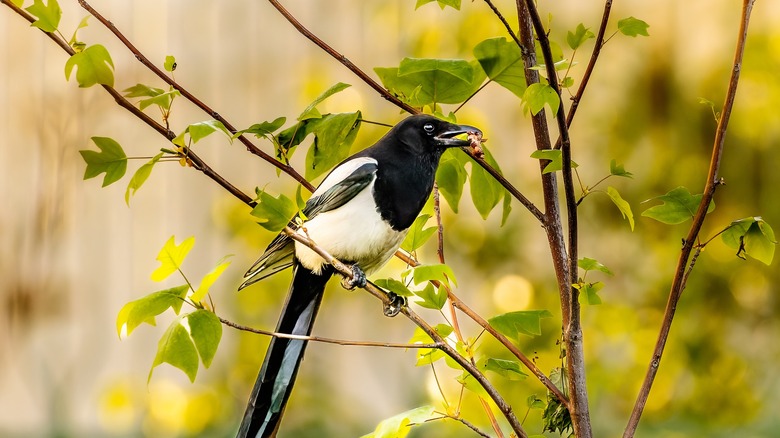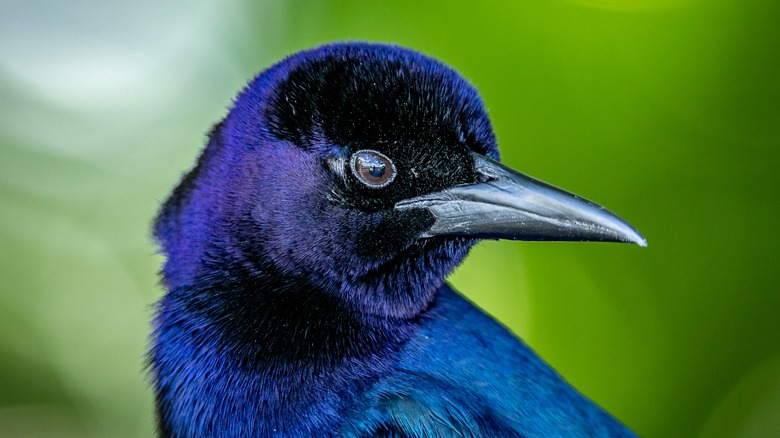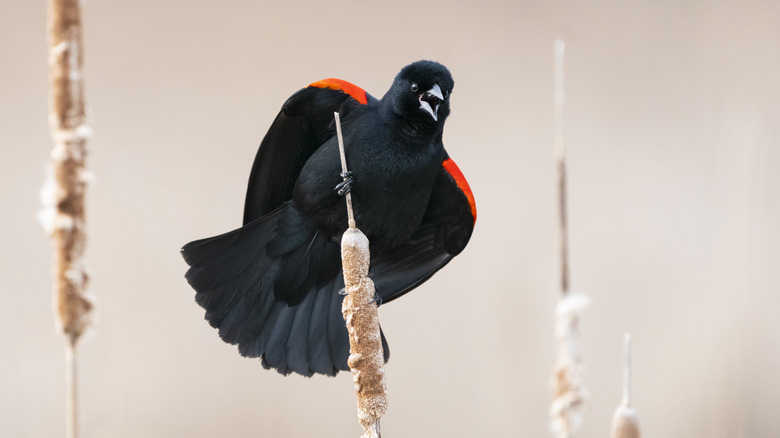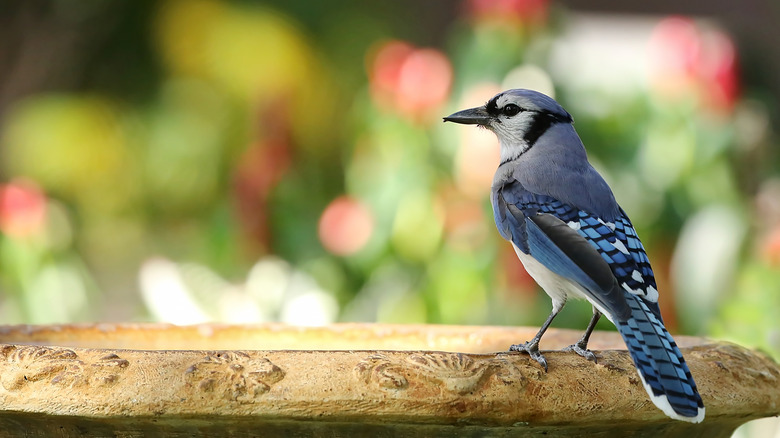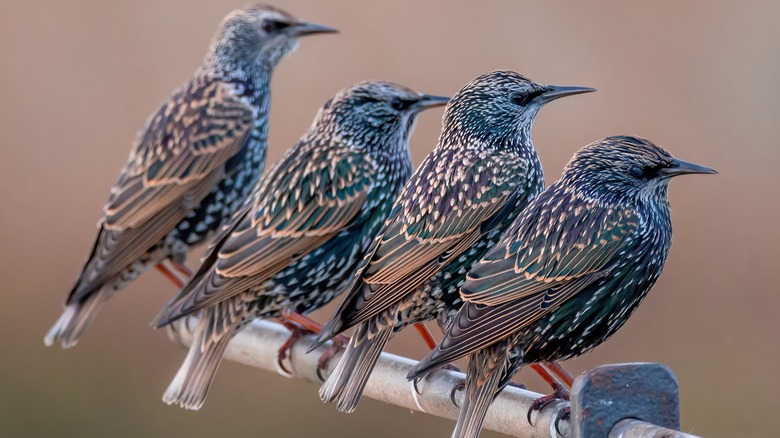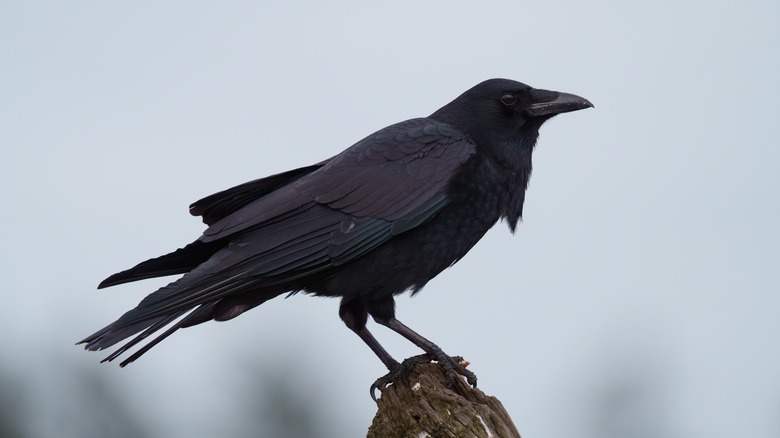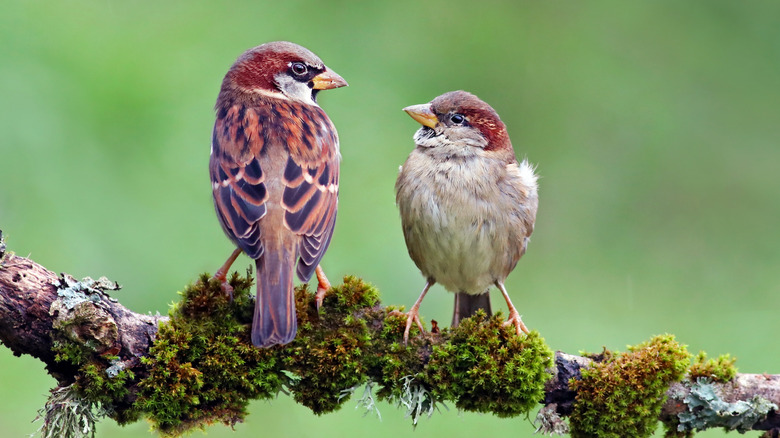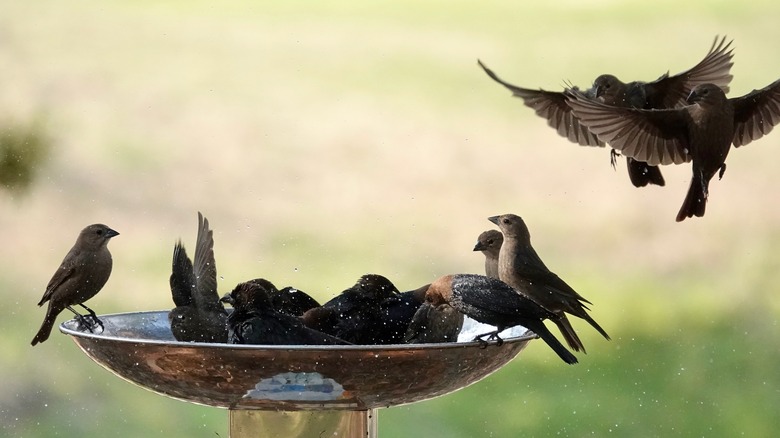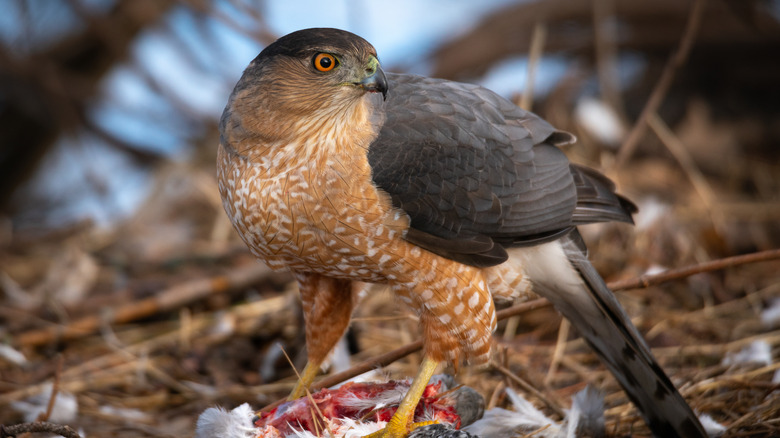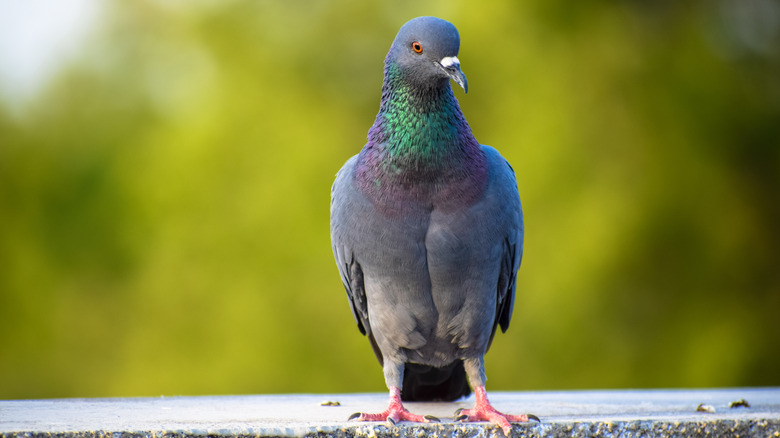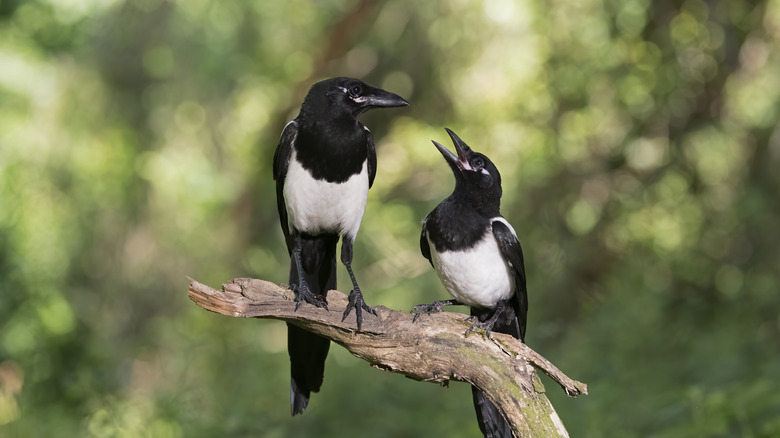Common Birds You Never Want To See At Your Bird Feeder
Bird-watchers are a pretty indiscriminate lot. Their love for the winged creatures extends far beyond admiration and can sometimes stretch into obsession. From robins, tufted titmice, and chickadees to woodpeckers, bluebirds, and cardinals, all birds are welcome at the backyard bird feeder. Well, almost all. There are a select few birds that are so aggressive that even the most sympathetic bird watcher wants nothing to do with them.
Though the majority of backyard birds are able to live harmoniously with one another, there are just those birds that don't like to play nice in the water bath. From bullying other birds away from the feeder to laying their eggs in other birds' nests of other birds, these avifauna can actually be quite damaging to the local ecosystem.
Some of the birds on this list will no doubt be familiar to you. Others you may not have heard about. Whichever camp you are in, we'll go over why these birds are unwelcome additions to your backyard and ways you can deter them from setting up shop for the long haul. Here are 10 common birds you never want to see at your bird feeder.
Common grackle
One thing you'll notice about all of the birds on this list is that they are incredibly beautiful in their own right, but they will certainly overstay their welcome sooner rather than later. The common grackle is one such bird. A type of blackbird, the common grackle is distinguished by its long, pointed beak and dark feathers, shimmering with hints of navy and forest green.
Common grackles are found primarily in the Eastern United States and Canada but have been seen as far west as Idaho. Their behavior towards other birds is akin to the schoolyard bully. Grackles are a bit larger than most songbirds and use that size to their advantage when it comes to bullying. Also, because grackles flock together, they can very easily take over an area, choking out the smaller birds and preventing them from getting any of the feed. They're also particularly messy, throwing seeds and emptying feeders like angry toddlers in the kitchen pantry.
One of the easiest ways to deal with grackles is to change the style of feeder you use. For instance, tube feeders with small perches are harder for the larger grackles to use. Bottom-accessed suet feeders are another good option. Overall, because they are so common, you're likely going to have to deal with grackles at least once in your backyard bird-watching life, but if you put the right precautions in place, they'll get frustrated and leave sooner rather than later.
Red-winged blackbird
Notable for their burnt orange shoulders, red-winged blackbirds have a fierce sense of territoriality. This means that once they have decided that your backyard is the place for them, they are going to defend it like it's their Alamo. They don't like any other birds venturing anywhere near their zone.
The bullying tactics of the red-winged blackbird are rather cruel. As opposed to just choking the other birds out from the feeders, the red-wings will go so far as to attack and physically chase birds away from their territory. And it is not just other birds the red-wings will go after. If you've got pets, these birds will have no problem attacking dogs and cats, regardless of the difference in size. They also have no issue attacking people, which makes them particularly aggravating and potentially quite dangerous because blackbirds are known to carry a number of harmful diseases.
Changing your feeder style will work to deter these birds, but you should also consider opting for a different variety of feed. Red-winged blackbirds love seed mixes, as they are very tasty and easy to eat. See if you can't swap this out for seeds like striped sunflower seeds or safflower seeds, as they have a much thicker shell that is difficult for the bird to break through. Thistle seeds, corn, millet, and wheat are also good options.
Blue jay
If there is one bird on this list that even the most patient of bird watchers loathe for their behavior, it's blue jays. They are ruthless bullies who are loud to boot. They really, and we mean really, like the sounds of their own voices. If that weren't enough to make them unwelcome, their treatment of other birds at the feeder certainly will be.
Like red-winged blackbirds, blue jays are extremely territorial. If your feeder happens to be in "their zone," they are going to attack any birds that come near. And it's not like the normal kind of bird scuffle. No, blue jays are so mean that they have been known to chase birds all the way back to their nests, kill them by decapitation, and then eat the eggs or nestlings. That is the ruthless kind of behavior that gives these birds such a bad reputation.
As far as what you can do to keep them away from your feeders, you might need to consider setting up a separate feeder for them in another area of your yard. Fill it with the kinds of seeds and nuts that they like, such as peanuts, suet cakes, and sunflower seeds. They're not fond of tube or cage feeders, so you might also consider using those as a method of keeping them at bay.
European starling
According to New York Invasive Species Information, European starlings were introduced to the United States in the year 1890. Apparently, a group of Shakespeare enthusiasts brought the birds in from overseas, releasing 100 of them into Central Park. That original 100 has grown into a population of more than 200 million, making the European starlings one of the most successful invasive species to ever exist in the United States. They compete with native birds for resources, destroy crops, and are generally unsanitary. You do not want these birds flocking to your backyard.
And flock they will, as European starlings stick together in massive numbers. Not only will their waste make your yard absolutely disgusting, but they will use numbers to their advantage to choke out the native bird population. Thanks to their relatively small size, they will easily crowd out all sorts of feeders while also making a mess of any bird baths you have in your yard. Plus, they are cavity nesters, meaning that if you've got a hole in your house or bird boxes in your yard, they are going to want to occupy those spaces and stick around.
Unfortunately, there is not much that will deter these little birds. They are not overly fond of suet cakes or cage feeders, but they will work their way around this. Regrettably, once the European starlings show up, they are here to stay, which is really a bummer.
American crow
The American crow gets something of a bad rep for quite a few things; some deserved and some not. They are not messengers of death, as so many have believed over the years, but they can be a nuisance to farmers and late-morning risers. And if there is one place you do not want them, it is at your backyard bird feeder. While the crows are not outright bullies, they often unwittingly serve as accomplices to other bullying birds.
Because crows travel in such large murders, their feeding and nesting habits can depress the population of other backyard songbirds. As a result, they open up the doors for the other bullying birds, like grackles, blue jays, and red-winged blackbirds. Deliberately feeding crows and other corvid birds will lead to an unnatural increase in their population.
Avoid leaving out human foods, like bread and certain meats, as they are highly attracted to this. Also, be sure to keep a tight lid on your trash bins. The main purpose of crows is to dispose of carrion, so they should really be more focused on that than on making their way through your bird feeders. Decoys are another excellent option for deterring crows.
House sparrow
Another invasive species that was introduced from Europe to the United States in the mid-1800s, the house sparrow is one of the most common birds those living in urban America will see. They can be somewhat amusing if they are the only birds at the feeder, bickering like an old married couple and generally displaying entertaining behavior. However, it's when other birds show up to the party that things can get a little nasty.
This is because house sparrows are extremely aggressive and will chase other birds away from the feeders in order to have it all to themselves. They are not above killing birds, such as Eastern bluebirds, in order to take over a nest and the food source for a particular area. Like their starling cousins, the house sparrow has now become endemic to the United States and serves as something of a problem for native species.
The annoying thing, too, also like the starling, is that once the house sparrows find a place that they like, they are bloody difficult to get rid of. They will defend their nests, raid the nests of other birds, not think twice about killing momma birds, and eat their young. Overall, not a very nice bird to have roaming your backwoods.
Brown-headed cowbird
Brown-headed cowbirds are what is known as a parasitic layer. They lay their eggs in the nests of other birds, oftentimes eating up other eggs in order for theirs to fit in. When hatched, the cowbirds are then fed and nurtured by the other bird. Owing to their larger size, this weakens the other nestlings and forces another bird to care for an offspring that is not theirs.
Now, their presence at bird feeders is not overly aggressive, especially when compared to the other birds we've seen on this list. Instead, the reason you don't want to see brown-headed cowbirds at your bird feeder is that they are going to force themselves upon the natural species that exist in your backyard. Because brown-headed cowbirds are either incapable or simply don't want to make nests for themselves, they will lay their eggs in the nests of over 200 different species of bird (via Forest Preserve District Will County).
Fortunately, there are a few things you can do to mitigate the presence of these birds at your feeder. Though not the largest birds on this list, brown-headed cowbirds are a bit bigger than the average songbird. So, tube feeders would work really well to deter them. Also, don't use any of the seeds they really like, such as millet, cracked corn, or sunflower seeds. The less access they have to easy food, the less likely they will be in your yard.
Hawks
Hawks are among the coolest of all birds flying in the sky. Their distinctive shapes, coupled with their impressive speed and strength, make hawks a wonder to behold. Unfortunately, their presence near your bird feeder is an indication of one thing: prey. If you've got a proliferation of hawks, like sharp-shinned or coopers hawks, in your yard, chances are they are going after the easy targets that are right there sitting at your bird feeders. And the last thing you really want to watch is a hawk making a meal out of your beloved songbirds.
Prey for hawks are some of the more common birds you want to attract to a feeder, such as robins, woodpeckers, and mourning doves. And while it's not as though they are attacking these birds just for the heck of it, having hawks chase away or eat your favorite birds is not the reason that you put them out in the first place. It's normal predation, but not really the thing you want to be seeing on a daily basis.
There are ways, however, that you can help your songbird friends elude raptors like hawks. If there is a significant brush pile up or decent-sized hedges in your yard, they are small enough to hide in there as a way of avoiding hawks. You can't stop hawks from being around your yard, but you can help out the other birds.
Rock pigeons
Here's the thing about rock pigeons — they're a mess. If you live in a city, chances are you've seen the evidence of their presence around your feeder, on the sidewalks, park statues, and steps up to your apartment. When there are enough of them, pigeons will leave piles of unsanitary waste all over your porch. And if that weren't enough, they also like to bully other birds away from the feeder.
Like the grackle or the European starling, rock pigeons use their massive numbers to choke other birds out of the bird feeder. To add to their detrimental mess, they also like to leave seeds all over the place, which, if not cleaned up, will attract rodents. And if you're already dealing with annoying birds at the feeder, adding rodents into the mix is not going to make things much better.
Cage feeders work particularly well against rock pigeons, as they are far too big to fit through the grates, and their necks are not long enough to reach the seed inside. Short perch feeders or tube feeders will also work in this respect. Avoid feeds like dried corn, peas, or sorghum, or find another feeder that specifically attracts these pigeons while leaving room for the other birds. However, depending on your city's ordinances, feeding rock pigeons might be against the law.
Magpie
Whether or not the Magpie is a harbinger of bad luck, they do bring a lot of it when they show up at your bird feeder. Magpies belong to the same family as crows and ravens. They are large birds with long, strong beaks and distinguishing white patches across their chests and wings. They also behave in a similar way to crows at the feeder, only with a much higher level of aggression.
Magpies are incredibly territorial. While they prefer animal and insect proteins as opposed to seeds, they will still chase birds away from feeders if they are hungry enough or if the feeder is a part of their claimed territory. They live in colonies as well, so the chances of there being more than one Magpie are pretty high.
The best way to avoid them, like with crows, is to remove their main food source. Seal up your trash barrels tightly, place protective measures over your garden and fruit trees, and make sure you're getting those smaller feeders that will be harder for them to access. All in all, whether or not these birds are welcome at your feeder is a matter of preference. Just know that if they are proliferating, chances are some harm is being done somewhere else in the environment.
